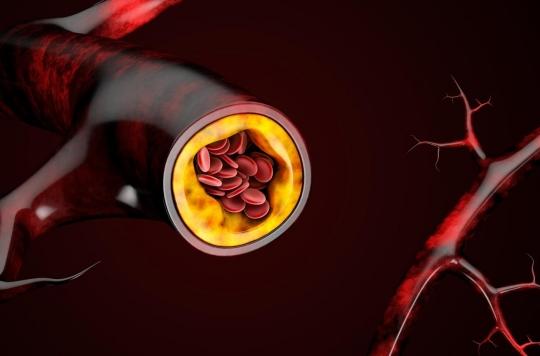Researchers have found a new technique for early detection of atherosclerosis. According to them, the disease can develop very quickly in people between the ages of 40 and 50.

- Atherosclerosis can weaken the heart muscle and cause a heart attack
- A study shows that the disease can develop as early as 40 or 50 years old
- A healthy lifestyle, and in particular physical activity, is the best prevention against this disease.
In France, cardiovascular disease is the second leading cause of premature death after cancer. Each year, there are approximately 120,000 cases of myocardial infarction and 150,000 strokes. These attacks are most often caused by atherosclerosis. The latter refers to the accumulation of fatty plaques in the arteries leading to the heart, causing the narrowing of blood vessels. This causes a reduction or, even worse, a blockage of blood flow. Those affected complain of chest pain, weakness, dizziness, pain in the arms or even shortness of breath.
Eventually, this disease can lead to a weakening of the heart muscle and lead to a heart attack. Unfortunately, it often has to come to that for doctors to discover it. However, at this stage, the treatments often have a limited effect. In a new study published in the Journal of American College of Cardiology, researchers have found a new technique for early detection of the disease. According to them, the latter develops very quickly in people aged 40 to 50, and not necessarily in a gradual and continuous way as previously thought.
To reach this conclusion, the researchers studied data collected over 10 years from 4,200 healthy middle-aged men and women. For their analyses, they compared two follow-up techniques: computed tomography imaging and ultrasound imaging. While the former requires exposure to a low dose of radiation, the latter does not.
The interest of ultrasound imaging
“The results show that ultrasound of the peripheral arteries is a more effective method to detect the progression of atherosclerosis”, comments Dr. Beatriz López-Melgar, lead author of the study. Using the ultrasound imaging technique, they were able to determine the buildup of fatty plaques in the arteries of the study participants and found that the disease progressed very rapidly in 40% of them.
“This study is the first to analyze the progression of atherosclerosis at frequent intervals. Previously, the disease was considered to progress very slowly throughout life”, comments Dr. Borja Ibañez, director of clinical research at the Centro Nacional de Investigaciones Cardiovasculares (CNIC) in Madrid (Spain). “Future data from [cette] starstudy will show whether this progression is associated with later cardiovascular events. So far, the rate of progression of atherosclerosis has not been a factor in individual risk assessment”he explains.
“In just 3 years, 40% of individuals between the ages of 40 and 50 showed major progression of atherosclerosis in distinct locations including the carotid, femoral and coronary arteries (…) This rapid disease progression could make these people more vulnerable to the onset of symptoms or clinical events, such as a heart attack or stroke.”adds Dr. López-Melgar.
Avoid the risk of complications in young subjects
This research has also identified evidence confirming the classic risk factors for atherosclerosis such as blood cholesterol, smoking, hypertension, overweight, diabetes, sedentary lifestyle, stress, excessive diet or consumption. excessive alcohol.
For Dr. Valentín Fuster, director of the CNIC and principal investigator of the study, the ultrasound imaging technique enabled the team to “identify disease progression earlier than traditional markers, such as the presence of coronary calcium detected by computed tomography (CT), allow us to identify high-risk individuals who may benefit from intervention early.”
Ultimately, the results of this study could therefore help to detect atherosclerosis more easily and to target younger people, thus being better able to stop the progression of the disease.
Have a healthy lifestyle
To limit the risk of atherosclerosis, health authorities advise watching your diet and playing sports regularly. Indeed, a healthy lifestyle would prevent hypercholesterolemia and obesity, two important factors in the development of the disease. Medications to lower cholesterol levels may also be prescribed.
“When an atheroma plaque is located, in particular by angiography, angioplasty can be considered. This technique consists of widening the artery using a small balloon that is inflated in order to restore its initial caliber. It is most often followed by the placement of a stent (small spring that keeps the artery open)”precise the foundation for medical research.

.

















